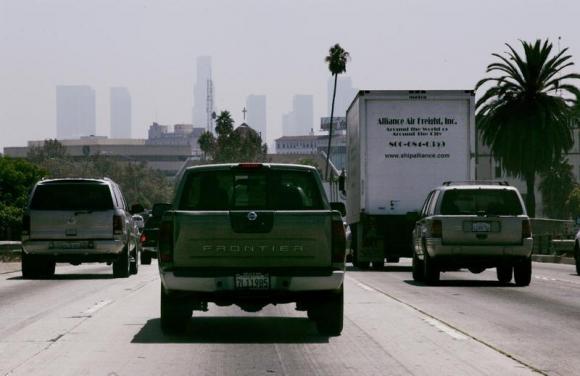New U.S. fuel standards aim to cut asthma, heart attacks
Date: 04-Mar-14
Country: USA
Author: Valerie Volcovici

Cars and trucks travel on a freeway in Los Angeles, California
August 31, 2006 with the skyline of Los Angeles barely visible in
background.
Photo: Fred Prouser
The Obama administration on Monday announced new fuel and automobile rules to cut soot, smog and toxic emissions, which it says will reduce asthma and heart attacks in the United States.
The so-called Tier 3 rules unveiled by the Environmental Protection Agency have been under development since President Barack Obama issued a memorandum instructing the agency to develop them in 2010.
The rules, the third tier in a series of standards, will cut gasoline sulfur levels by more than 60 percent and should also reduce tailpipe and evaporative emissions from cars, light and medium-duty trucks and some heavy-duty vehicles.
Health advocates praised the move, while a petroleum refiners' group called the compliance schedule "unrealistic" and warned of potential supply disruptions.
The rules will be phased in under schedules that vary by vehicle class, generally starting between model years 2017 and 2025, the EPA said.
Once fully in place, the standards will help avoid up to 2,000 premature deaths per year and 50,000 cases of respiratory ailments in children while adding only an average of 1 cent per gallon to the cost of gasoline, the agency estimated.
Total health benefits in 2030 will be between $6.7 billion and $19 billion annually, the EPA said.
The standards are an attempt to cut the sulfur content of gasoline to 10 parts per million from 30 ppm currently. This would boost efficiency for new emission control technologies that automakers will use to help achieve the administration's wider clean car standards, the agency said.
Every gasoline-powered vehicle on the road built prior to the Tier 3 standards will run cleaner, cutting smog-forming nitrous oxide emissions by 260,000 tons in 2018.
"By reducing these pollutants and making our air healthier, we will bring relief to those suffering from asthma, other lung diseases and cardiovascular disease, and to the nation as a whole," said Dr. Albert Rizzo, former chairman of the American Lung Association.
Industry groups complained that the new standards were not based on a timetable that is achievable by refiners.
Charles Drevna, president of the American Fuel and Petrochemical Manufacturers, said his group had discussed its concerns about the implementation schedule numerous times with the EPA.
"EPA chose to ignore our concerns by setting an unrealistic compliance date of January 1, 2017," he said, adding that the schedule could cause supply disruptions.
The EPA said it had considered the feedback of stakeholders, including refiners and automakers. It said the sulfur rules include a program to help refiners and importers meet the new standard, and gives smaller refiners more time to comply.
QUESTIONS ABOUT COST
The EPA and the American Petroleum Institute, a lobbying group for the U.S. energy industry, sparred over the potential health benefits and costs of the rules.
The EPA estimated that the final standards would provide up to $13 in health benefits for every dollar spent to meet the standards and raise gasoline prices by just 0.065 cents per gallon.
The standards will have an average cost of about $72 per vehicle in 2025, the agency said.
But the API said the new rules would result in negligible health benefits and undue costs.
"This rule's biggest impact is to increase the cost of delivering energy to Americans, making it a threat to consumers, jobs and the economy," said Bob Greco, director of the API'S Downstream Group. The organization estimates the rules would increase gasoline prices by 6 cents to 9 cents per gallon.
EPA Administrator Gina McCarthy told reporters on a conference call that the benefits far outweighed the costs.
"The estimate that API and others are relying on is an outdated estimate of what they thought we would be proposing," she said.
Nor did they account for the compliance flexibilities the EPA added to the rule before the final release, she added.
"People will see immediate benefits in 2017," she said, and the estimated cost of under a penny per gallon of gasoline would not take effect until 2025, when the rule is fully in place.
Frank O'Donnell, president of nonprofit group Clean Air Watch, said Monday's rule was "the most significant move to protect public health that the EPA will make this year" and that the oil industry's fears about costs were often overblown.
"Let's remember the oil industry has cried wolf so many times," O'Donnell said, "and it's doing it again here."
(Editing by Ros Krasny, David Gregorio and Lisa Von Ahn)
![]()
© Thomson Reuters 2014 All rights reserved